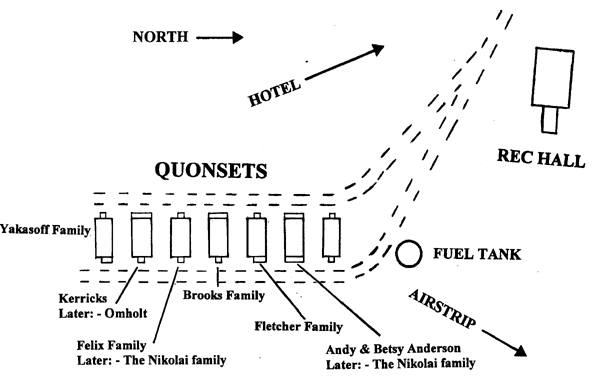To the east of the tracks, also, was a row of seven
Quonset huts, set up as family quarters. There were tales that the Quonsets
were originally an Army fishing camp. To the north of the Quonsets, was a
raised stove-oil tank, resembling a miniature water tower.
This was a time when society still had an air of "class
distinction." The Quonsets were essentially for the lesser-class workers;
add any 'desperate' needs for housing.
For the sake of preserving memories, the following
diagram is as close as I remember – including the shapes of the various
porches:

The "Train House" was located
to the southeast of the hotel. To the northeast of that was a big black-tarred
Quonset hut, with a nearby water tower. The oversized Quonset hut had a D-6
cat housed there, which was the only snow removal gear, for winter.
When there came a snowfall, the hotel
train platform was attended to by volunteers wielding shovels, with a two-man
push-box for doing 'mass' snow removal. The snow would be pushed off the north
end of the platform, which had around a 12-foot drop.
When my family arrived in Curry, a small
school was set up in the southeast corner of the old 'annex' portion of the
hotel. When my father later got a liquor license, the school was moved to
an old barracks building; the former 'school house' was then set up as a chapel.
The 'preacher' of the day was "Reverend Urban."

LOOKING TO THE NORTHWEST
The school teacher in 1955 was Mrs. Rouse.
She was replaced in 1956 by Mrs. Virginia Pine. Mrs. Rouse was an incredibly
kind lady, fond of children; also a former registered nurse. Mrs. Pine was the
daughter of Christian missionaries and quite the disciplinarian.
The 'school' had maybe 12 pupils at its
peak, when I lived there. When I left, there were four – not even a 'legal'
number for a Territorial School.
One of the railroad workers was Al Yakasoff,
a kind soul, well-spoken; wearing thick-lensed glasses. He appeared to be half
Indian, Athabascan, I presume. I think he worked at the Curry power plant. His
wife, Ruth, was working as a waitress at the hotel. They had a daughter, Carol
(Al's step-daughter), who had two daughters of her own, while she was there,
Connie and Mary – known most commonly as "Sister." Carol wasn't
living there, when we first moved to Curry. I think it was around six months
later, that she moved in with her parents.
Our original handyman and janitor was a
Filipino, by the name of Leo. He was rather quiet, and quite the artist. One
of his creations was a gift to me; a butterfly shaped kite, which he covered
with green and yellow crepe paper. I remember that he used to have two pieces
of crystallized metal – seemingly iron chalcopyrite. I spent quite a few
occasions examining those two 'rocks.' One was bright silver, the other was
gold. Leo teased me that they were pure gold and silver – I believed him!
When Leo left, Dad hired a handyman, Jim
Blakely; who had a Mexican wife, Linda, and two daughters; Christie and Marie.
The main portion of the hotel had a central
lobby, with a wide carpeted stairway leading to the second floor. Underneath
and behind that stairway was the main hallway, with rooms on either side, leading
to the old annex portion. In the lobby, to the right of the stairway, against
the wall was a huge fireplace.
Page 3 | Index
| Page 5

